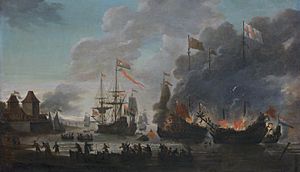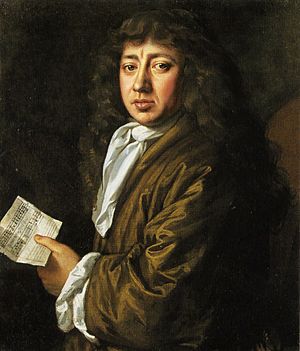Raid on the Medway facts for kids
Quick facts for kids Raid on the Medway |
|||||||
|---|---|---|---|---|---|---|---|
| Part of the Second Anglo-Dutch War | |||||||
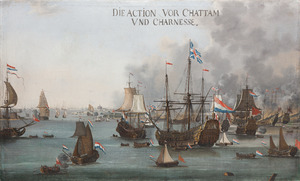 Attack on the Medway, June 1667, by Willem van der Stoop |
|||||||
|
|||||||
| Belligerents | |||||||
| Commanders and leaders | |||||||
|
|||||||
| Strength | |||||||
|
|
||||||
| Casualties and losses | |||||||
|
|
||||||
The Raid on the Medway was a surprise attack by the Dutch navy on English warships. It happened in June 1667 during the Second Anglo-Dutch War. The Dutch fleet attacked English ships docked at Chatham Dockyard and Gillingham in Kent. These ships were supposed to be protected by Upnor Castle and a strong chain across the river.
The Dutch, led by Willem Joseph van Ghent and Michiel de Ruyter, first captured the town of Sheerness. Then they sailed up the Thames estuary to Gravesend. After that, they entered the River Medway and reached Chatham and Gillingham. There, they fought against English forts and ships. They burned or captured three large warships and ten other ships of the line. They also took the English fleet's main ship, HMS Royal Charles, and towed it away.
This raid was a huge blow to King Charles II's war plans. It quickly led to the end of the war, with the Dutch getting a good peace deal. It was one of the worst defeats in the Royal Navy's history. Many people called it the most serious defeat the British military ever had in its home waters.
Contents
Why the Dutch Attacked
In 1667, England's navy was not ready for battle. King Charles II had spent too much money, so many large warships were out of service. The Dutch saw this as a chance to attack. They had planned a similar attack in 1666 but couldn't carry it out.
The main person behind the Dutch plan was Johan de Witt, a powerful Dutch politician. His brother, Cornelis de Witt, went with the fleet to make sure the plan was followed. Peace talks were happening in Breda, but Charles II was delaying. He hoped to get secret help from France. De Witt wanted to end the war quickly with a clear Dutch victory. This would ensure a better peace deal for the Dutch Republic.
Most Dutch admirals were worried about the attack. They feared the dangerous shallow areas in the Thames estuary. But they followed orders. The Dutch even used two English pilots who had switched sides. These pilots knew the local waters well.
The Raid Begins
The Dutch Fleet Sets Sail
On May 17, the Dutch fleet gathered. By June 4, Michiel de Ruyter sailed towards the Thames. He had 62 large warships, about 15 smaller ships, and 12 fireships. The fleet was divided into three groups. Willem Joseph van Ghent was the overall commander of the mission. He had planned the operation carefully.
On June 6, the Dutch fleet was seen sailing into the mouth of the Thames. On June 7, Cornelis de Witt told all commanders the secret plan. Many officers had doubts, but De Ruyter simply said, "orders are orders." The next day, most officers seemed ready for the adventure. They had just wanted to record their concerns in case things went wrong. The Dutch tried to capture English merchant ships but failed.
England's Lack of Preparation
The attack completely surprised the English. They had not prepared well, even though their spies had warned them. Most English warships were far away. The London area had only a few active ships, mostly captured from the Dutch. To save money, many ship crews had been sent home. Only three guard ships were left at the Medway.
There was a lot of confusion in England. King Charles II did not take strong control. English soldiers and sailors had not been paid for months. They were not eager to risk their lives. England had a small army, and its units were spread out. This explains why no strong defense was put up. It took the Dutch about five days to reach Chatham. They moved slowly through the shallow waters.
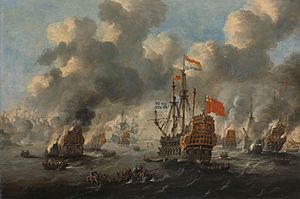
On June 6, an alarm was raised at Chatham Dockyard. But Commissioner Peter Pett did not do much until June 9. That afternoon, about 30 Dutch ships were seen in the Thames near Sheerness. Pett immediately asked the Navy for help. He sent a worried message, saying he needed senior officials. These 30 ships were part of Van Ghent's fleet.
The Dutch fleet carried about a thousand marines. Landing parties went ashore at Canvey Island and Sheerness. Cornelis de Witt strictly ordered them not to steal. The Dutch wanted to shame the English, who had looted Terschelling in 1666. However, some Dutch sailors did not obey. They were driven off by English soldiers. One captain, Jan van Brakel, offered to lead the next day's attack to avoid punishment.
On June 8, King Charles ordered soldiers to gather around London. He also wanted barges to create a bridge across the Thames. This would allow cavalry to move quickly. On June 9, Vice-Admiral Edward Spragge learned that Dutch raiders had landed.
Only on the afternoon of June 10 did Charles order Admiral George Monck to go to Chatham. This was three days after the Dutch were sighted. Monck first went to Gravesend. He saw that there were too few guns to stop a Dutch advance. He ordered all available cannons from London to be moved there.
On June 11, Monck went to Chatham. He expected it to be ready for an attack. But he found only 12 of 800 dockyard workers. They were in a panic. Only 10 of 30 small boats were there. The others had been used to move officials' belongings. There were no weapons or gunpowder. The thick iron chain across the Medway was not protected by cannons. This chain had been built during the English Civil War. Monck immediately ordered cannons from Gravesend to Chatham. This would take a day.
The Main Attack

The Dutch fleet reached the Isle of Sheppey on June 10. They attacked the unfinished Garrison Point Fort. Captain Jan van Brakel sailed his ship Vrede close to the fort and fired cannons. The English frigate Unity was the only ship defending.
Unity fired once, but then retreated when a Dutch fireship attacked. The Dutch fired on the fort. Most Scottish soldiers there deserted. About 800 Dutch marines landed nearby. Sheerness was lost, its guns captured, and the fort blown up. Spragge sailed upriver to Chatham. Many English officers were now at Chatham. They gave conflicting orders, causing total confusion.
Since his cannons would not arrive soon, Monck ordered soldiers to reinforce Upnor Castle. Ships were quickly sunk to block the river. The chain across the river was guarded by small groups of cannons. Pett suggested sinking more ships to block a channel in front of the chain. Several large and small English ships were sunk. The men meant to protect the warships were used to sink these ships. So, the most valuable ships had no crews. These sunken ships were placed too far east to be covered by fire. Monck then decided to sink more ships near Upnor Castle. The main chain across the river was too low. Light Dutch ships could still pass over it.
The English ships Charles V and Matthias were moved to fire on the chain. Monmouth was also placed to fire on the gap between them. More ships were sunk. Pett also told Monck that Royal Charles needed to be moved upriver. He had been ordered to do this earlier but had not. Monck at first refused to give him boats. When he finally found a captain willing to help, Pett said it was too late.
Van Ghent's fleet moved up the Medway on June 12. They attacked the English defenses at the chain. First, Unity was captured by Van Brakel. Then, the fireship Pro Patria broke through the chain. Some say Dutch engineers used hammers to break it.
Next, Matthias was burned. Two fireships attacked Charles V. One was sunk, but the other, Schiedam, set Charles V on fire. Its crew was captured. The English flagship Royal Charles had only 30 cannons. Its crew abandoned it when they saw Matthias burn. An Irishman named Thomas Tobiasz captured Royal Charles. It was then towed to the Netherlands. Only Monmouth escaped. Seeing the disaster, Monck ordered all 16 remaining warships to be sunk. This was to prevent the Dutch from capturing them. In total, about 30 English ships were sunk by their own side.
On June 13, London was in a panic. Rumors spread that the Dutch were bringing a French army for a full invasion. Many rich citizens fled the city with their valuables. The Dutch continued into the Chatham docks with fireships. They faced fire from Upnor Castle and three shore batteries. Dutch warships fired back. Three of England's best and heaviest ships, already sunk to prevent capture, were burned. These were Loyal London, Royal James, and Royal Oak. English crews abandoned their ships, mostly without a fight. One army captain, Archibald Douglas, refused to leave Royal Oak and died in the flames. Monmouth escaped again. The raid cost England four of its remaining eight large ships. Three of the four biggest ships were lost. The last big ship, Royal Sovereign, was safe in Portsmouth.
Samuel Pepys's Story
Samuel Pepys was the secretary of the Navy Board. His diary tells us a lot about how people felt during the raid.
At first, Pepys thought the Dutch would not attack London. But on June 3, he realized the Dutch fleet was out in force. By June 10, he knew the Thames was their target. He wrote, "News brought us that, the Dutch are come up as high as the Nore; and more pressing orders for fireships." On the morning of June 12, he felt better after hearing about Monck's defenses.
But soon, his confidence was shattered. He heard the Dutch had broken the chain at Chatham. He wrote, "which struck me to the heart." He went to White Hall to find out the truth. He heard servants talking about "sad newes" and how everyone looked like they had been crying.
Pepys immediately thought this meant the end of King Charles's rule. He believed a revolution was coming. He wrote, "All our hearts do now ake; for the newes is true, that the Dutch have broke the chaine and burned our ships... I do fear so much that the whole kingdom is undone." He even decided to plan with his family what to do with his money.
The whole city was in a panic. Then, even worse news came. A neighbor told Pepys that he had seen Royal James, Oake, and London burned by the enemy. He said Dutch ships paid no attention to Upnor Castle's firing.
On June 14, more details came out. English sailors on Dutch ships were heard speaking English. They said, "We did heretofore fight for tickets; now we fight for dollars!" This showed how unhappy the English sailors were. People in the streets of Westminster were shouting, "A Parliament! a Parliament!" This showed their anger towards King Charles.
The Dutch Leave
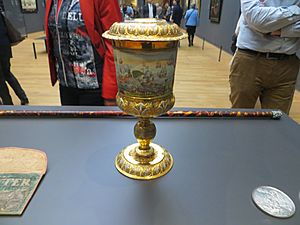
Cornelis de Witt decided to pull back on June 14. He thought the English resistance would get stronger. The Dutch towed Royal Charles away as a war trophy. Unity was also taken. This decision saved some large English ships that had been sunk. However, Dutch sailors still rowed to any English ship they could reach to set it on fire. One boat even went back into the docks to burn the remains of Royal Oak, Royal James, and Loyal London.
The shore buildings of Chatham Dockyard were not destroyed. This was lucky because it meant the Royal Navy could repair its sunken ships later. English villages were actually looted by their own troops, not the Dutch.
After their victory, the Dutch fleet celebrated. They thanked God for "a great victory in a just war in self-defense." They tried to attack other English ports but were stopped each time. On July 21, peace was signed.
On July 29, 1667, Pepys wrote: "Thus in all things, in wisdom, courage, force, knowledge of our own streams, and success, the Dutch have the best of us, and do end the war with victory on their side."
What Happened Next
An official named John Norman estimated the damage from the raid at about £20,000. This did not include the cost to replace the four lost large ships. The total loss for the Royal Navy was around £200,000. Peter Pett was blamed for the disaster. He lost his job, while others who ignored his warnings were not punished.
Royal James, Royal Oak, and Loyal London were eventually pulled from the water and rebuilt. But it cost a lot of money. When the City of London refused to help pay, King Charles changed the name of Loyal London to simply London. For a few years, the English fleet was weaker. But by 1670, a new shipbuilding program had made the English Navy strong again.
The Raid on the Medway greatly damaged the reputation of the English crown. King Charles felt personally insulted. He was angry that the Dutch attacked while his fleet was laid up and peace talks were happening. His anger was one reason for the Third Anglo-Dutch War. He secretly made a deal with King Louis XIV of France.
The Dutch had only about 50 casualties and lost eight fireships. In the Netherlands, people were overjoyed by the victory. Many celebrations were held. The admirals were seen as heroes. They received golden chains and pensions. De Ruyter, Cornelis de Witt, and Van Ghent were given beautiful golden cups showing the events. Cornelis de Witt had a large painting made of himself celebrating the victory.
Royal Charles was too deep to sail in the shallow Dutch waters. So, it was kept in a drydock near Hellevoetsluis as a tourist attraction. People took day trips to see it. King Charles protested that this insulted his honor. So, official visits ended, and Royal Charles was eventually broken up for parts in 1672. However, part of its back section, with the English coat of arms, was saved. It has been on display in the Rijksmuseum in Amsterdam since 1883.
On March 14, 2012, this part of Royal Charles was brought to England. It was displayed at the National Maritime Museum in Greenwich. This was part of an exhibition for Queen Elizabeth II's Diamond Jubilee.
Images for kids
See also
- Glossary of nautical terms : (A–L), (M–Z)


